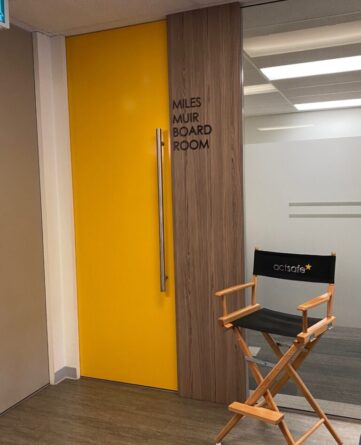HUMBLE BEGINNINGS: A LOOK BACK AT HOW ACTSAFE BEGAN
In 1998 Titanic became the highest-grossing film of all time. And while it received many accolades, the human costs of creating the film are never discussed, when in fact several injuries and illness occurred during filming. Extras suffered broken bones and a ruptured spleen, actress Kate Winslet suffered hypothermia and 80 crew members were hospitalized after eating some bad clam chowder. So what does the Titanic have to do with Actsafe? While Titanic soared to the top of the box office charts that year, here in Vancouver Miles Muir, a technical director with over 30 years in the entertainment industry, sat around a table at a bar with his colleagues trying to figure out how to bring more safety regulation to the performing arts and motion picture industries. “One of the biggest challenges at the time was that the dangers in our industry were not being recognized. I wanted to find a way to ensure that everybody was safe and protected,” he says.
With the help of Mark Thompson, the group decided to create their own organization—one that would not only be a resource for crew and cast members, but also advocate for the health and safety of those working in the industry.

They modeled the organization on a concept adopted by the Farmers Safety Association (now known as AgSafe) and established an industry association dedicated to promoting health and safety in the film, television, theatre, dance, music and performing arts industries in British Columbia. Originally named SHAPE (Safety and Health in Arts Production and Entertainment), the organization recognized the unique nature of the arts and entertainment industry and began working with employers, workers, as well as WorkSafeBC to improve health and safety in the workplace through information, education, and industry consultation.
“Back then, recognizing the importance of health and safety in the arts and entertainment industry was like an ostrich—people had their heads in the sand. Pulling people out of that sand has been crucial, and because of this, there is now recognition of the legitimate safety concerns that people face on set and in live performances,” says Miles.
Twenty-five years later, Miles says we’ve come a long way from being ostriches. “People now recognize the potential dangers of both sides of the industry, making it safer for everyone.”
In 2010, SHAPE rebranded as Actsafe to reflect the clarity and directness that we seek in our day-to-day interactions with stakeholders. What began as a grassroots initiative to make the arts and entertainment industry safer for cast and crew members has now turned into a trusted resource for industry—providing information, training and resources aligned with today’s changing technology and new ways of working.
“One of the biggest challenges at the time was that the dangers in our industry were not being recognized. I wanted to find a way to ensure that everybody was safe and protected.”
– MILES MUIR
Today, Vancouver is known as ‘Hollywood North’—one of Canada’s largest film-producing centres and home to a vibrant arts scene that hosts stage performances, events and concerts employing tens of thousands of workers across B.C. As the industry continues to grow, so does the need to bring regulation and guidelines to protect the health and safety of those bringing art to life. As the industry evolves, so do the hazards that workers face every day.
To keep with the pace of change, Actsafe has been an active participant on the frontlines— listening to the safety concerns of everyone of set so that we can focus our efforts on the greatest safety concerns impacting the industry today. Safe workplaces do not happen by coincidence, and creating a culture of safety requires the collaborative efforts of everyone to ensure cast and crew members go home safely at the end of each day. Thanks to continued collaboration with industry, Actsafe has been able to move the needle on health and safety in the arts and entertainment industry and continues to make a difference. We look forward to seeing what we can accomplish in the next 25 years!


